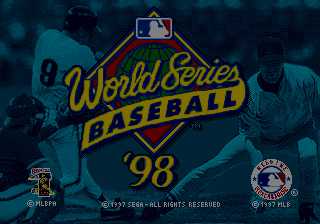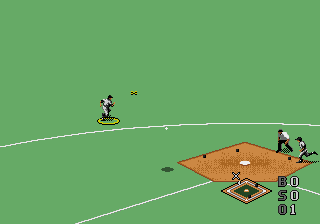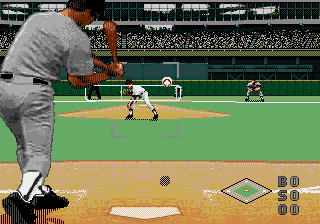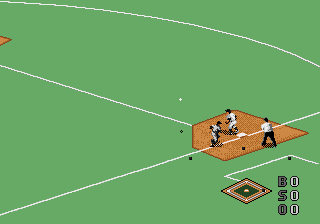Difference between revisions of "World Series Baseball 98 (Mega Drive)"
From Sega Retro
m (Text replacement - "==Technical information== ===" to "==Technical information== {{mainArticle|{{PAGENAME}}/Technical information}} ===") |
|||
| Line 150: | Line 150: | ||
==Technical information== | ==Technical information== | ||
{{mainArticle|{{PAGENAME}}/Technical information}} | {{mainArticle|{{PAGENAME}}/Technical information}} | ||
| − | |||
| − | |||
| − | |||
| − | |||
==References== | ==References== | ||
Revision as of 11:16, 22 April 2023
- For the Sega Saturn game, see World Series Baseball 98 (Saturn).
| World Series Baseball 98 | ||||||||||
|---|---|---|---|---|---|---|---|---|---|---|
| System(s): Sega Mega Drive | ||||||||||
| Publisher: Sega | ||||||||||
| Developer: BlueSky Software | ||||||||||
| Licensor: Major League Baseball Properties, Major League Baseball Players Association | ||||||||||
| Sound driver: GEMS | ||||||||||
| Genre: Sports | ||||||||||
| Number of players: 1-2 | ||||||||||
|
World Series Baseball 98 is a Sega Mega Drive baseball game developed by BlueSky Software and published by Sega. Released exclusively in the United States in July 1997, the game is an update to the developer's previous game World Series Baseball '96, with the only substantial addition to the game being an updated player roster.
Contents
Gameplay
The game plays identically to World Series Baseball '95 for the Sega Mega Drive. It features all 28 teams and 700 players from the 1997 MLB season, along with all 28 ballparks. The game additionally features several special teams: the American League Stars, National League Stars, and MLB Stars (consisting of the best players from each league or from both leagues) and the American League Legends, National League Legends, and MLB Legends (all-star teams including historical players such as Roberto Clemente). The 1998 expansion teams, the Arizona Diamondbacks and the Tampa Bay Devil Rays, are also present. However, as neither team had yet played a game at the time of the game's release, they are not available for league play and have fictional rosters (containing the names of the developers).
- Exhibition: A single game against a human or computer player. The player can also watch two computer-controlled teams play. Assigning control to a human is done before the game by moving the player to a team with
 or
or  , then the game is started with START .
, then the game is started with START . - League: Plays a season of games that culminate in the World Series. The player can choose the number of games (13, 26, 52, 104, or a full 162 games) and the number of divisions (4 or 6). The game has the ability to draft and trade players. There is a mid-season All-Star Game whose members are chosen based on the player's season. This version of the game adds interleague games, which were introduced to the 1997 MLB season. The game uses a battery backup to save the player's progress.
- Playoffs: A truncated season with only the play-offs. Progress in this mode is also saved using the battery backup.
- Batting Practice: The player practices batting. There are no outs in this mode. The player can select a left- or right-handed pitcher, a left- or right-handed batter, the type of pitch, and the venue.
- Home Run Derby: Players have 10 attempts to hit as many home runs as possible. A missed attempt is a hit that is not a home run; there are no strike-outs. This mode can be played by up to 8 players taking turns.
- Classic Home Run Derby: This mode is a home run competition that retains outs and innings. Like a standard baseball game, the player pitches during one half of the inning and hits in the other half, but there is no fielding or baserunning. The player with the most home runs after nine innings is the winner. It can be played by one or two players.
The scoreboard is shown at the beginning of the game and after each play (and can be shown by calling a time-out with START ). The scoreboard has a menu that allows players to set the batting line-up, change the defensive position of each player, and choose the starting and relief pitchers. Starting pitchers have more stamina than relief pitchers, but players can have up to two relievers warm up to their maximum stamina in the bullpen. The scoreboard also provides options including selecting the difficulty for pitching and batting separately (Rookie, Veteran, or All-Star), setting the length of the game (3, 6, or 9 innings) before the first pitch, and toggling auto-fielding.
Teams
| League | Division | Team |
|---|---|---|
| American | Western | Anaheim Angels |
| Oakland Athletics | ||
| Seattle Mariners | ||
| Texas Rangers | ||
| Central | Chicago White Sox | |
| Cleveland Indians | ||
| Kansas City Royals | ||
| Milwaukee Brewers | ||
| Minnesota Twins | ||
| Eastern | Baltimore Orioles | |
| Boston Red Sox | ||
| Detroit Tigers | ||
| New York Yankees | ||
| Toronto Blue Jays | ||
| Unassigned | Tampa Bay Devil Rays | |
| National | Western | Colorado Rockies |
| Los Angeles Dodgers | ||
| San Diego Padres | ||
| San Francisco Giants | ||
| Central | Chicago Cubs | |
| Cincinnati Reds | ||
| Houston Astros | ||
| Pittsburgh Pirates | ||
| St. Louis Cardinals | ||
| Eastern | Atlanta Braves | |
| Florida Marlins | ||
| Montreal Expos | ||
| New York Mets | ||
| Philadelphia Phillies | ||
| Unassigned | Arizona Diamondbacks |
Magazine articles
- Main article: World Series Baseball 98 (Mega Drive)/Magazine articles.
Physical scans
| Sega Retro Average | |||||||||
|---|---|---|---|---|---|---|---|---|---|
|
| 65 | |
|---|---|
| Based on 1 review | |
Technical information
- Main article: World Series Baseball 98 (Mega Drive)/Technical information.
References
- ↑ http://riehlspot.simplenet.com:80/vgame/new/genesis.html (Wayback Machine: 1998-01-31 04:05)
- ↑ GamePro, "October 1997" (US; 1997-xx-xx), page 158
| World Series Baseball 98 (Mega Drive) | |
|---|---|
|
Main page | Hidden content | Magazine articles | Reception | Region coding | Technical information | |
| Games in the World Series Baseball Series | |
|---|---|
| World Series Baseball (1994) | World Series Baseball '95 (1995) | World Series Baseball '96 (1996) | World Series Baseball 98 (1997) | |
| World Series Baseball (1993) | World Series Baseball '95 (1994) | Nomo's World Series Baseball (1995) | |
| World Series Baseball Starring Deion Sanders (1995) | |
| World Series Baseball (1995) | World Series Baseball II (1996) | World Series Baseball 98 (1997) | |
| World Series Baseball '96 (1996) | |
| World Series 99 (1999) | World Series Baseball (2001) | |
| World Series Baseball 2K1 (2000) | World Series Baseball 2K2 (2001) | |
| World Series Baseball (2002) | World Series Baseball 2K3 (2003) | |
| World Series Baseball related media | |
| Prima's Official Strategy Guide: World Series Baseball 2K1 (2000) | |








